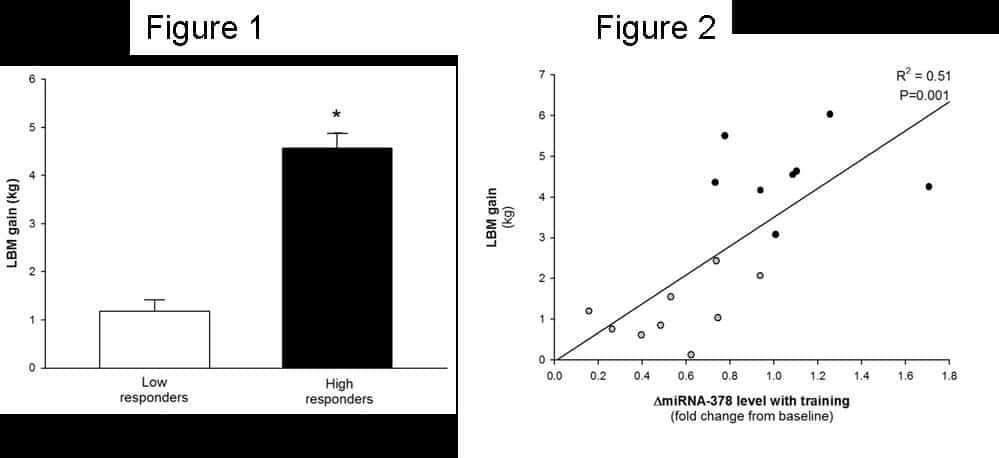Background: MicroRNAs (miRNA), small non-coding RNA molecules, are emerging regulatory factors of protein synthesis. Resistance exercise training (RT) is an efficient strategy for increasing muscle mass through stimulation in muscle protein synthesis. However, RT increases muscle mass with a very wide range of effectiveness in humans. In the present study we determined the expression level of 19 highly abundant miRNAs to determine the potential for variation miRNAs expression to explain the variation in RT-induced gains in muscle mass in humans. Approach: Vastus lateralis muscle biopsies were obtained from 56 young men before and after undertaking a 5days per week RT-program for a total duration of 12 wks. Training-induced muscle mass gain was determined by dual-energy X-ray absorptiometry (DEXA). Prior to any molecular analysis the top-eight and bottom-nine (in terms of RT induced gain in muscle mass) were designated high- and low responders, respectively (Figure 1). Next, the expression level of 19 abundant miRNAs in skeletal muscle was quantified by TaqMan based real-time qPCR in the two responder groups, with the investigator being blinded to the sample identity. Results: The majority of the nineteen mature miRNAs examined were stable during RT and did not differ between high and low responders. However, miR-378, miR-29a, miR-26a and miR-451 were differentially expressed between low- and high responders. miR-378, miR-29a, miR-26a were down-regulated in low responder subjects and unchanged in high responders while miR-451was up-regulated in low responders. Interestingly, training-induced changes in miR-378 abundance was positively correlated with muscle mass gains (Figure 2).Conclusions: We report for the first time that lack of RT induced human skeletal muscle hypertrophy is associated with selected changes in miRNA abundance, suggesting that miRNAs may play a role in the pronounced intersubject variation.
University of Manchester (2010) Proc Physiol Soc 19, PC162
Poster Communications: The impact of resistance exercise training on skeletal muscle microRNA expression
P. K. Davidsen1, I. J. Gallagher2, J. W. Hartman3, M. A. Tarnopolsky3, D. Flemming1, J. W. Helge1, J. A. Timmons2,1, S. M. Phillips3
1. Centre for Healthy Ageing, University Copenhagen, Copenhagen, Denmark. 2. Royal Veterinary College, London, United Kingdom. 3. Exercise Metabolism Research Group, McMaster University, Hamilton, Ontario, Canada.
View other abstracts by:
Where applicable, experiments conform with Society ethical requirements.

